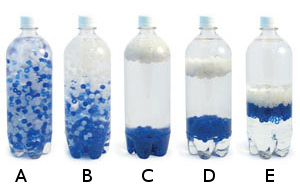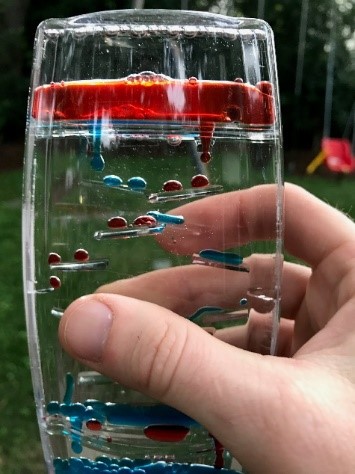 by Linda Dunnavant
by Linda Dunnavant
The ZigZag Density Tumbler is an elegant desk “toy” and much more. Turn the tumbler over and watch two different colors of droplets float down in a relaxing zigzag pattern. I like to keep mine on my desk. I often pick it up and watch it while I clear my head. Not only is the tumbler a soothing, relaxing activity for busy adults, but it also provides so many possibilities for calming, inspiring, and teaching students.
The ZigZag Density Tumbler in the Classroom
 As teachers, we need many tricks up our sleeve to engage our students in inquiry. The ZigZag Density Tumbler is a great tool to get students engaged in asking questions about scientific principles. Here are some questions to engage students:
As teachers, we need many tricks up our sleeve to engage our students in inquiry. The ZigZag Density Tumbler is a great tool to get students engaged in asking questions about scientific principles. Here are some questions to engage students:
- What do you notice?
- Can you describe what you see happening?
- What do you think will happen if you turn the tumbler on its side?
- Can you list the properties of the contents of the tumbler?
- How many different liquids does the tumbler contain?
- How do you think the droplets get their energy?
- Can you infer anything about the substances inside the tumbler?
- What do you notice about the size and speed of the droplets?
- How does the shape of the droplets change as they fall?
Students need to see examples of science concepts in action instead of merely reading about them in a textbook. The ZigZag Density Tumbler can be used to demonstrate several different common science concepts. Teachers have limited budgets, so it is a boon to be able to find a single item that can serve so many purposes!
Here is a list of the science concepts that can be illustrated with the ZigZag Density Tumbler:
Insolubility
One of the first things students will notice when watching the ZigZag Density Tumbler is that the clear and colored liquids do not mix inside the tumbler, even when it is shaken. This is a perfect introduction to the idea of solutions and solubility. Even the youngest students will be intrigued by this concept.
You can have students hypothesize why they think the two liquids inside the tumbler do not mix. Students can then take it a step further by mixing other liquids, such as water and oil, to test their solubility. Older students can investigate even further by exploring suspensions and emulsions in addition to solutions.
Density
The ZigZag Density Tumbler clearly illustrates how fluids of different density will separate. Density can be a difficult concept for students to grasp, so it is advantageous to have density experiments as a visual aid for students to see the concept in action. Students can shake the ZigZag Density Tumbler and easily see how the different liquids separate because of their different densities.
If I were teaching a unit on density, I would show students the ZigZag Density Tumbler and explain that the different liquids do not mix because they have different densities. I would then have students hypothesize the definition of density based on what they see happening in the ZigZag Tumbler. This type of discovery makes learning more meaningful for students because they are able to discover the concept on their own without being just told the definition.
For an even greater demonstration of density, miscibility, and insolubility, consider the Poly Density Kit. When you shake the bottle, the blue and white beads mix as expected. However, when allowed to settle, the beads separate, white at the top and blue at the bottom. Then, the two separated colored beads slowly come together in the center of the liquid. How often do you see something floating in the middle of the liquid? This discrepant event demo is sure to intrigue students and get them talking about density.
Surface Tension
 Surface tension is another concept that students frequently have difficulty understanding. The ZigZag Density Tumbler provides a wonderful visual of how surface tension works. As the colored droplets fall through the clear liquid in the tumbler, they take on a spherical shape. This demonstrates the tension on the surface of the droplets, causing them to acquire the least possible surface area to minimize potential energy. However, as the droplets hit the surfaces of the small zigzagging ramps, they deform due to gravity and develop flattened bottom surfaces.
Surface tension is another concept that students frequently have difficulty understanding. The ZigZag Density Tumbler provides a wonderful visual of how surface tension works. As the colored droplets fall through the clear liquid in the tumbler, they take on a spherical shape. This demonstrates the tension on the surface of the droplets, causing them to acquire the least possible surface area to minimize potential energy. However, as the droplets hit the surfaces of the small zigzagging ramps, they deform due to gravity and develop flattened bottom surfaces.
Types of Energy
Have students observe the ZigZag Density Tumbler on a table to observe potential and kinetic energy. When the colored liquid is at the bottom, it has no potential energy. Flip the Tumbler, and now the colored liquid has potential energy (which you supplied in the process of flipping). As the colored liquid tumbles down, this potential energy is converted to kinetic energy.
The ZigZag Density Tumbler beyond the Classroom
These days we are constantly inundated with stimuli. Phones buzzing, screens shining, ads intruding. This sensory overload is especially overwhelming for children. As adults, we can tune out extraneous stimuli, but children often cannot. The ZigZag Density Tumbler is a great way to take a break from the hustle and bustle of our busy, non-stop lives. It’s the perfect outlet for students—or anyone—who needs a quiet moment.
Aside from helping you to demonstrate various scientific principles, the tumbler can be used in the classroom or at home in many ways. For instance:
Take a Break
 As a teacher and a mom, I am always looking for positive and healthy ways to help kids process their big feelings. Instead of putting kids in time out for misbehavior, I like to encourage kids to take a “time in.” This can mean just taking a moment to breathe and calm down. Calm Down Jars are tools for kids to look at while they sit, reflect, and compose themselves. These jars are usually made from household ingredients: a Mason jar filled with colored water and glitter.
As a teacher and a mom, I am always looking for positive and healthy ways to help kids process their big feelings. Instead of putting kids in time out for misbehavior, I like to encourage kids to take a “time in.” This can mean just taking a moment to breathe and calm down. Calm Down Jars are tools for kids to look at while they sit, reflect, and compose themselves. These jars are usually made from household ingredients: a Mason jar filled with colored water and glitter.
The ZigZag Density Tumbler is a wonderful alternative for several reasons. First, it is very reasonably priced, and probably does not cost much more than it would to purchase all the materials to make your own Calm Down Jar. Because it takes some time for all the colored droplets to settle to the bottom of the ZigZag Density Tumbler, it also gives kids more quiet time to process their emotions. Finally, the tumbler is made from plastic and is far safer than using a heavy glass jar.
Use It as a Timer
Kids don’t seem to share the same sense of time that we do as adults. I can say, “We are leaving in five minutes,” and my kids still seem surprised when I tell them the time us up and we need to leave. The ZigZag Density Tumbler is a wonderful visual timer to kids. Try saying, “We are leaving when all the droplets have settled at the bottom of the tumbler.” This gives kids a visual cue for when it is time to leave.
I often use the ZigZag Density Tumbler as a timer with my five-year-old. He loves it. He actually looks for things for me to time, instead of me having to beg him to hurry up. Last night, he said, “Set the timer to see if I can get my pajamas on before it’s done!” This was a welcome change from our usual routine which involves me asking, “Please put your pajamas on,” more times than I would like to admit!
The Perfect Quiet Activity
Sometimes I take my kids places where they are expected to be very quiet. Church, airplanes, graduation ceremonies, the DMV… the list goes on and on. I keep our ZigZag Density Tumbler in my bag so that I can pull it out when I need the kids to sit and quietly entertain themselves for a bit. It came in handy several times on our recent vacation! Best of all, the ZigZag Density Tumbler is silent, safe, and easily transportable.
Conclusion
The ZigZag Density Tumbler is a great multi-purpose tool. It is entertaining and soothing to play with. Better still, it can help encourage inquiry and demonstrate complex science concepts. This lovely device is a huge hit at my house. I think you will enjoy it, too!
Linda Dunnavant is a middle school teacher. Her blog is “Tales of a Fifth Grade Teacher.”

